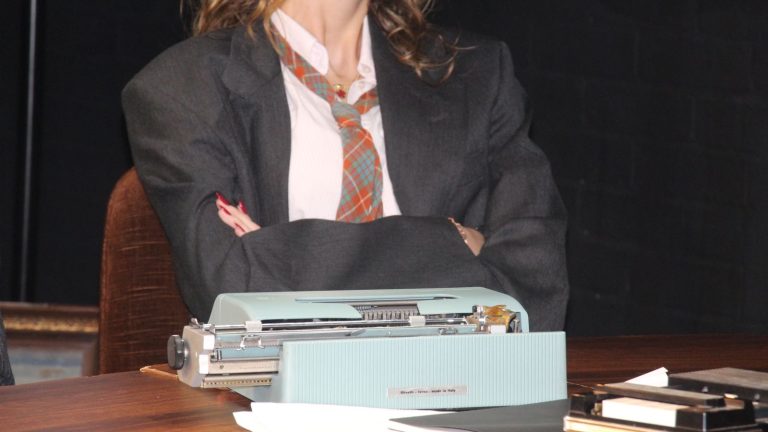To What End is a new meta-theatrical, absurdist play written by Billy Skiggs and Billy Hearld. It begins in what seems to be simplicity: a wartime song hums through the intimate Burton Taylor Studio, where two actors (Luke Carroll and Georgina Cotes) sit quietly on opposite sofas, leafing through books as the audience arrives, instantly immersing you within the production. The music gets louder, and the pair dance to ‘We’ll Meet Again’ by Vera Lynn. Yet what follows is far from a traditional period drama. Skiggs and Hearld’s new play quickly unravels into a chaotic, witty, and unsettling exploration of theatre itself – an investigation of ambition, authorship, and the futility of performance.
The premise is deceptively simple. Two directors, Albie (Peregrine Neger) and Bernard (Tomasz Hearfield), are staging what they think to be “the greatest theatrical work of the century”. Their actors, rehearsing a wartime romance, stumble through a scene in which love is declared across enemy lines. Then, the rehearsal goes wrong: the script is unfinished, and Bernard can’t find the ending. From that moment, logic begins to disintegrate. The rehearsal collapses into arguments. Arguments lead to an interrogation. An interrogation leads to the courtroom. All the settings blend reality and fiction until neither can be distinguished.
Hearld and Skiggs’ script dismantles every structure it builds. It’s a play which is obsessed with its own undoing. An interrogation becomes a quiz show; the courtroom devolves into knock-knock jokes. Each scene doubles back on itself, revealing a performance where we thought there was truth. It’s reminiscent of absurdist, tragicomic theatre: Stoppard’s Rosencrantz and Guildenstern Are Dead, or Beckett’s Endgame – words pile up but meaning continually slips away. The ensemble handled the rapid tonal shifts with impressive precision. Even as scenes dissolved into absurdity, the actors maintained a sense of rhythm that kept the audience engaged.
Much of the play’s humour is brought about by the sharp contrast between its central figures, convincingly acted by Peregrine Neger and Tomasz Hearfield. Albie, with his formal diction, and Bernard, with his colloquial language and vape in hand, represent two poles of theatre: the classical and the contemporary. Wartime songs sit uneasily beside the hiss of the vape, formal RP accents clash with modern slang – the production feels unmoored from time. History consistently bleeds into contemporary life. The ever-present tape recorder suggests the stage itself is a trap, a loop from which no one can escape. It’s deliberately chaotic; confusion becomes the medium through which meaning is made.
The introduction of two police interrogators named Stager (Sanaa Pasha) and Trouper (Madison Howarth) extends the play’s meta-theatrical joke: even the agents of authority are theatrical archetypes. Their questioning unfolds as if the theatre itself is on trial, forcing its makers – and by proxy, the audience – to confront the question of what performance is for.
The fictional directors allow chaos (and even tragedy) for the sake of a ‘better performance’, a possible satirical commentary on how art can exploit real suffering. Quoting Macbeth and invoking its superstition underlines the theme of doomed ambition and the blurred boundary between play and reality. Like Macbeth himself, the characters’ desire to create something great leads to their own undoing. Even the play’s humour feels haunted by this awareness, leaving the audience complicit in the spectacle: laughing at the chaos, yet uneasily aware of its consequences. At times, the relentless layering of meta-theatrical conceits risked overwhelming emotional clarity, but this excess felt deliberate, a part of the play’s critique of theatrical self-obsession. It ends where it began – with the ‘actors’ and ‘characters’ merging again, leaving the audience uncertain as to what is real. Just as the directors and actors seem trapped in endless rehearsals and re-enactments, the audience too is left asking the question posed by the title: all this, to what end?












